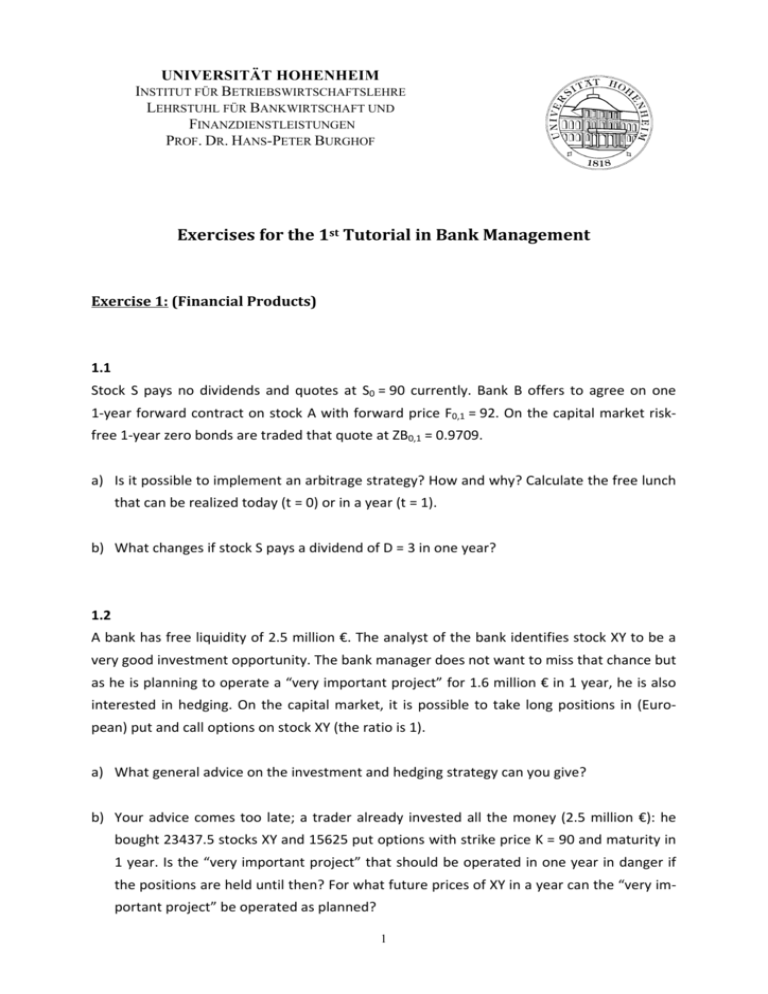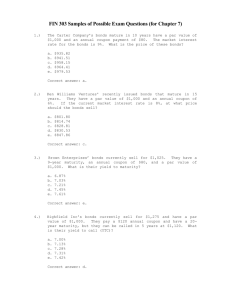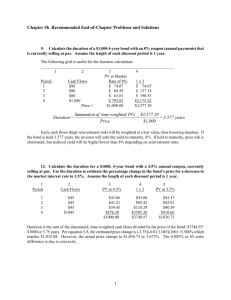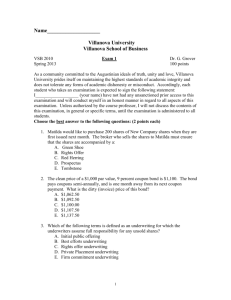Bank Management Exercises: Financial Products & Risk
advertisement

UNIVERSITÄT HOHENHEIM INSTITUT FÜR BETRIEBSWIRTSCHAFTSLEHRE LEHRSTUHL FÜR BANKWIRTSCHAFT UND FINANZDIENSTLEISTUNGEN PROF. DR. HANS-PETER BURGHOF Exercises for the 1st Tutorial in Bank Management Exercise 1: (Financial Products) 1.1 Stock S pays no dividends and quotes at S0 = 90 currently. Bank B offers to agree on one 1‐year forward contract on stock A with forward price F0,1 = 92. On the capital market risk‐ free 1‐year zero bonds are traded that quote at ZB0,1 = 0.9709. a) Is it possible to implement an arbitrage strategy? How and why? Calculate the free lunch that can be realized today (t = 0) or in a year (t = 1). b) What changes if stock S pays a dividend of D = 3 in one year? 1.2 A bank has free liquidity of 2.5 million €. The analyst of the bank identifies stock XY to be a very good investment opportunity. The bank manager does not want to miss that chance but as he is planning to operate a “very important project” for 1.6 million € in 1 year, he is also interested in hedging. On the capital market, it is possible to take long positions in (Euro‐ pean) put and call options on stock XY (the ratio is 1). a) What general advice on the investment and hedging strategy can you give? b) Your advice comes too late; a trader already invested all the money (2.5 million €): he bought 23437.5 stocks XY and 15625 put options with strike price K = 90 and maturity in 1 year. Is the “very important project” that should be operated in one year in danger if the positions are held until then? For what future prices of XY in a year can the “very im‐ portant project” be operated as planned? 1 Exercise 2: (Bond Valuation, Duplication and “Martkzinsmethode”) Bank B provides the following loans to an AAA rated company: Loan 1: 3 years, repayment completely at maturity, credit amount 100, interest rate 0.035, Loan 2: 2 years, repayment of 50% after 1 year, credit amount 100, interest rate 0.04. On the capital market, three coupon bonds with AAA ratings (that is, with negligible default risk) and yearly interest payments are traded: Coupon bond 1: maturity in 1 year, nominal interest rate 0.04 p.a., full price 101.9616, Coupon bond 2: maturity in 2 years, nominal interest rate 0.05 p.a., full price 105.3765, Coupon bond 3: maturity in 3 years, nominal interest rate 0.02 p.a., full price 98.3164. a) Calculate the arbitrage‐free price of a 1‐year, a 2‐year and a 3‐year zero bond. b) Calculate the market value and the net present value of both loans. c) Bank B wants to refinance loan 2 with 1‐year coupon bonds. Calculate the expected cash flows of the bank if the bonds are priced correctly. Determine the expected mismatch contribution and customer interest contribution of loan 2. 2 Exercise 3: (Default Risk) 3.1 On the arbitrage‐free capital market, there are two coupon bonds facing default risk: Coupon bond 1: maturity in 2 years, nominal interest rate 0.03 p.a., face value 100, Coupon bond 2: maturity in 2 years, nominal interest rate 0.08 p.a., face value 100. Both bonds face the same risk, the risk‐adequate discrete discount rates are i0,1 = 0.03 and i0,2 = 0.065. The survival probabilities for both bonds are s1 = 0.98 and s2 = 0.93. The risk‐free rate is 0.02 p.a. (flat risk‐free yield curve). a) Calculate the value and the recovery of the two coupon bonds for different reference quantities of the RR (that is, recovery of par value, recovery of initial investment, recovery of market value, recovery of Treasury, and recovery of accrual). Assume that the recovery rate is RR = 40%. 3.2 Regard a CDS contract on a bond with a par value of 100. The CDS is quoted at 350 bps and has a maturity of 0.75 years; the premium is paid quarterly. The underlying bond faces the following survival probabilities: S(0.25) = 0.99, S(0.5) = 0.98 and S(0.75) = 0.96. The risk‐ adequate market interest rate is flat at i = 0.03 p.a. In case of default of the bond, the CDS contract terms ascertain that the protection buyer gets the bonds par value recovered by the protection seller. The best assumption for the recovery of the bond be the recovery of par value with a recovery rate 0f 40 %. a) Determine the value of the CDS contract for the protection seller and for the protection buyer. 3











